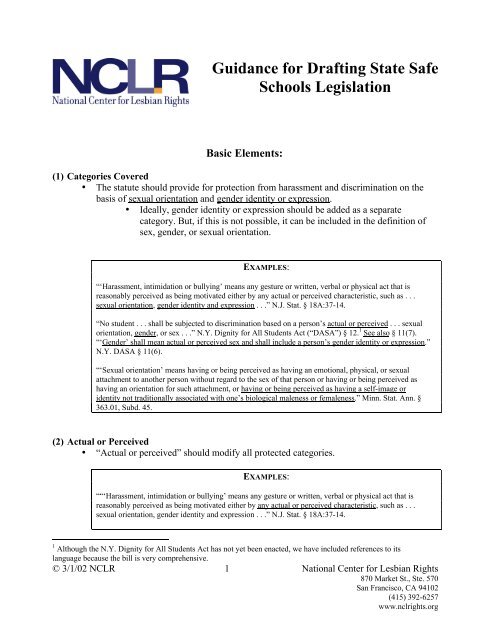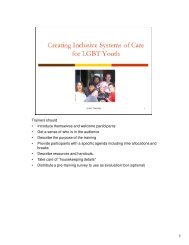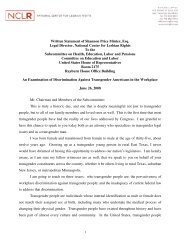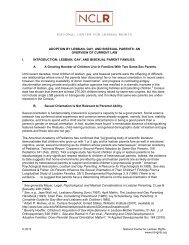Guidance for Drafting State Safe Schools Legislation
Guidance for Drafting State Safe Schools Legislation
Guidance for Drafting State Safe Schools Legislation
Create successful ePaper yourself
Turn your PDF publications into a flip-book with our unique Google optimized e-Paper software.
<strong>Guidance</strong> <strong>for</strong> <strong>Drafting</strong> <strong>State</strong> <strong>Safe</strong><br />
<strong>Schools</strong> <strong>Legislation</strong><br />
Basic Elements:<br />
(1) Categories Covered<br />
The statute should provide <strong>for</strong> protection from harassment and discrimination on the<br />
basis of sexual orientation and gender identity or expression.<br />
Ideally, gender identity or expression should be added as a separate<br />
category. But, if this is not possible, it can be included in the definition of<br />
sex, gender, or sexual orientation.<br />
EXAMPLES:<br />
“‘Harassment, intimidation or bullying’ means any gesture or written, verbal or physical act that is<br />
reasonably perceived as being motivated either by any actual or perceived characteristic, such as . . .<br />
sexual orientation, gender identity and expression . . .” N.J. Stat. § 18A:37-14.<br />
“No student . . . shall be subjected to discrimination based on a person’s actual or perceived . . . sexual<br />
orientation, gender, or sex . . .” N.Y. Dignity <strong>for</strong> All Students Act (“DASA”) § 12. 1 See also § 11(7).<br />
“‘Gender’ shall mean actual or perceived sex and shall include a person’s gender identity or expression.”<br />
N.Y. DASA § 11(6).<br />
“‘Sexual orientation’ means having or being perceived as having an emotional, physical, or sexual<br />
attachment to another person without regard to the sex of that person or having or being perceived as<br />
having an orientation <strong>for</strong> such attachment, or having or being perceived as having a self-image or<br />
identity not traditionally associated with one’s biological maleness or femaleness.” Minn. Stat. Ann. §<br />
363.01, Subd. 45.<br />
(2) Actual or Perceived<br />
“Actual or perceived” should modify all protected categories.<br />
EXAMPLES:<br />
““‘Harassment, intimidation or bullying’ means any gesture or written, verbal or physical act that is<br />
reasonably perceived as being motivated either by any actual or perceived characteristic, such as . . .<br />
sexual orientation, gender identity and expression . . .” N.J. Stat. § 18A:37-14.<br />
1<br />
Although the N.Y. Dignity <strong>for</strong> All Students Act has not yet been enacted, we have included references to its<br />
language because the bill is very comprehensive.<br />
© 3/1/02 NCLR 1 National Center <strong>for</strong> Lesbian Rights<br />
870 Market St., Ste. 570<br />
San Francisco, CA 94102<br />
(415) 392-6257<br />
www.nclrights.org
STATE SAFE SCHOOLS LEGISLATION<br />
“No student . . . shall be subjected to discrimination based on a person’s actual or perceived . . . sexual<br />
orientation, gender, or sex . . .” N.Y. DASA § 12.<br />
“‘Sexual orientation’ means having or being perceived as having an emotional, physical, or sexual<br />
attachment to another person without regard to the sex of that person or having or being perceived as<br />
having an orientation <strong>for</strong> such attachment, or having or being perceived as having a self-image or<br />
identity not traditionally associated with one’s biological maleness or femaleness.” Minn. Stat. Ann. §<br />
363.01, Subd. 45.<br />
(3) Coverage <strong>for</strong> Discrimination on the Basis of Association<br />
Ideally, the statute should explicitly prohibit harassment on the basis of association<br />
(which would cover harassment of students with LGBT parents).<br />
If that is not possible, however, statutes that have been written to prohibit<br />
discrimination or harassment against any person on the basis of race, color,<br />
sex, sexual orientation, gender identity, etc. have been interpreted to cover<br />
discrimination on the basis of a person’s association with an individual who<br />
falls within one of the protected categories. 2<br />
EXAMPLES:<br />
“Harassment of and discrimination and violence against students on the basis of real or perceived<br />
identity or expression of . . . sex or gender . . . or sexual orientation, on the basis of stereotypes of<br />
persons identified by these categories, or on the basis of association with others identified by these<br />
categories are prohibited by any student or school employee . . .” Florida DASA § 3(a). 3<br />
(4) Prohibited Conduct<br />
The statute should prohibit “discrimination.”<br />
Harassment is a <strong>for</strong>m of discrimination, so a statute that prohibits<br />
discrimination also requires a school to respond to incidents of harassment. But,<br />
not all <strong>for</strong>ms of discrimination are “harassment,” so a statute that only prohibits<br />
“harassment” would not, <strong>for</strong> example, prohibit a school from excluding a<br />
student from class on the basis of the student’s sexual orientation. Thus, it is<br />
very important to make sure that the statute explicitly prohibits<br />
“discrimination.” To make it clear that the statute also prohibits harassment, the<br />
2 See, e.g., Indiana Civil Rights Com’n v. Alder, 714 N.E.2d 632 (Ind. 1999); Minneapolis v. <strong>State</strong>, 310 N.W.2d 485<br />
(Minn. 1981); West Virginia Human Rights Com’n v. Wilson Estates, Inc., 202 W. Va. 152, 503 S.E.2d 6 (W. Va.<br />
1998); Winchell v. English, 62 Cal. App. 3d 125, 133 Cal. Rptr. 20 (citing cases). Thus, statutes written this way (or<br />
something similar, such as prohibiting discrimination “on account of . . .”) are likely to prohibit harassment directed at<br />
a student because the student has (an) LGBT parent(s).<br />
A statute is less likely to be interpreted to cover such associational discrimination if the statute is worded to<br />
prohibit discrimination against any person because of the sexual orientation (or other protected category) “of such<br />
person.” See generally Civil Rights: Actionability Under <strong>State</strong> Statutes of Discrimination Because of Complaining<br />
Party’s Association With Persons of Difference Race, Color, or the Like, 35 A.L.R. 3d 859.<br />
3 Similarly, although the Florida Dignity <strong>for</strong> All Students Act has not yet been enacted, we have included references to<br />
its language because the bill is very comprehensive.<br />
© 9/03 NCLR 2 National Center <strong>for</strong> Lesbian Rights<br />
870 Market St., Ste. 370<br />
San Francisco, CA 94102<br />
(415) 392-6257<br />
www.nclrights.org
STATE SAFE SCHOOLS LEGISLATION<br />
statute can explicitly prohibit both “harassment” and “discrimination,” as the<br />
New York bill does.<br />
EXAMPLES:<br />
“No student shall be subjected to harassment . . . nor shall any student be subjected to discrimination . .<br />
.” N.Y. DASA § 12 (emphasis added).<br />
(5) Retaliation<br />
The statute should prohibit retaliation against any person who reports discriminatory or<br />
harassing behaviors (this provision is sometimes referred to as a “whistle-blower”<br />
clause).<br />
“Retaliation against a student by another student or school employee <strong>for</strong> asserting or alleging a violation<br />
of this act is prohibited.” Florida DASA § 3(b).<br />
“Protection of people who report discrimination or harassment. Any person having reasonable cause to<br />
suspect that a student has been subjected to discrimination or harassment by an employee or student, on<br />
school grounds or at a school function, who, acting reasonably and in good faith, either reports such<br />
in<strong>for</strong>mation to school officials, to the commissioner, or to law en<strong>for</strong>cement authorities or otherwise<br />
initiates, testifies, participates or assists in any <strong>for</strong>mal or in<strong>for</strong>mal proceedings under this article, shall<br />
have immunity from any civil liability that may arise . . . and no school district or employee shall take,<br />
request or cause a retaliatory action against any such person . . .” N.Y. DASA, § 16.<br />
(6) Activities Covered<br />
The statute should cover any activity or program occurring on the grounds of a covered<br />
institution during the hours in which school is in session, all school-related and schoolsponsored<br />
programs or activities, and transportation on a school bus to or from school<br />
or a school-related or school sponsored program or activity.<br />
EXAMPLES:<br />
Prohibiting “[h]arassment, intimidation or bullying” that “takes place on school property, at any schoolsponsored<br />
function or on a school bus . . .” N.J. Stat. § 18A:37-14.<br />
“Harassment of and discrimination and violence against students . . . are prohibited by any student or<br />
school employee during the conduct of any education program or activity by an educational institution<br />
which receives or benefits from state or federal financial assistance, as well as on any school bus<br />
traveling to or from a school or a school-related or school-sponsored program or activity.” Florida<br />
DASA § 3(a).<br />
© 9/03 NCLR 3 National Center <strong>for</strong> Lesbian Rights<br />
870 Market St., Ste. 370<br />
San Francisco, CA 94102<br />
(415) 392-6257<br />
www.nclrights.org
STATE SAFE SCHOOLS LEGISLATION<br />
(7) People Covered<br />
Ideally, the statute should cover students, teachers, employees, and staff.<br />
EXAMPLES:<br />
“It is an unfair discriminatory practice (1) to discriminate in any manner in the full utilization of or<br />
benefit from any educational institution, or the services rendered thereby to any person . . .” Minn. Stat.<br />
Ann. § 363.03, Subd. 5 (emphasis added).<br />
(8) Types of <strong>Schools</strong> Covered<br />
The statute should cover all grade levels -- k-12 and, if possible, post-secondary.<br />
Post-secondary schools can be covered within the same statute (see NJ), or<br />
by way of a separate statute (see CA).<br />
Ideally, the statute should cover public and private schools.<br />
If the statute does cover private schools, it may be advisable or necessary to<br />
include a religious exemption.<br />
EXAMPLES:<br />
“‘Educational institution’ means a public or private institution and includes an academy, college,<br />
elementary or secondary school, extension course, kindergarten, nursery, school system, and a business,<br />
nursing, professional, secretarial, technical, vocational school; and includes an agent of an education<br />
institution.” Minn Stat. Ann. § 363.01, Subd. 15 (emphasis added).<br />
“‘A place of public accommodation’ shall include . . . any kindergarten, primary and secondary school,<br />
trade or business school, high school, academy, college and university, or any educational institution<br />
under the supervision of the <strong>State</strong> Board of Education, or the Commissioner of Education of the <strong>State</strong> of<br />
New Jersey . . .” N.J. Stat. Ann. § 10:5-5(l) (emphasis added).<br />
“It is the policy of the <strong>State</strong> of Cali<strong>for</strong>nia to af<strong>for</strong>d all persons, . . . regardless of any basis that is<br />
contained in the prohibition of hate crimes set <strong>for</strong>th in subdivision (a) of Section 422.6 of the Penal<br />
Code, equal rights and opportunities in the postsecondary institutions of the state. . . .” Cal. Educ. Code §<br />
66251 (emphasis added). Compare Cal. Educ. Code § 200 (applying to “educational institutions of the<br />
state”).<br />
“This article shall not apply to an educational institution which is controlled by a religious organization<br />
if the application would not be consistent with the religious tenets of that organization.” Cal. Educ. Code<br />
§ 220.5 (emphasis added).<br />
(9) Implementing Policies and Procedures<br />
The statute should authorize the <strong>State</strong> Board of Education (or its equivalent) to<br />
promulgate rules and regulations to implement the statute.<br />
© 9/03 NCLR 4 National Center <strong>for</strong> Lesbian Rights<br />
870 Market St., Ste. 370<br />
San Francisco, CA 94102<br />
(415) 392-6257<br />
www.nclrights.org
STATE SAFE SCHOOLS LEGISLATION<br />
EXAMPLES:<br />
“The <strong>State</strong> Board of Education shall adopt regulations . . . to implement this chapter.” Cal. Educ. Code §<br />
221.1.<br />
“The Florida Board of Education shall adopt rules pursuant to §§ 120.536(a) and 120.54 to implement<br />
and monitor compliance with this act.” Florida DASA § 5.<br />
(10) Severability and Construction Clause<br />
The statute should include a severability clause.<br />
It is also helpful to have a sentence stating that the statute is to be liberally construed.<br />
EXAMPLES:<br />
“Severability and construction. The provisions of this title shall be severable, and if any court of<br />
competent jurisdiction declares any phrase, clause, sentence or provisions of this title to be invalid, or its<br />
applicability to any government agency, person or circumstance is declared invalid, the remainder of this<br />
article and its relevant applicability shall not be affected. The provisions of this article shall be liberally<br />
construed to give effect to the purposes thereof.” N.Y. DASA § 18.<br />
Requirements <strong>for</strong> School Districts:<br />
(1) School District Policies<br />
The statute should require all school districts to adopt anti-harassment/nondiscrimination<br />
policies consistent with the statute.<br />
Ideally, the statute should require the policy to include en<strong>for</strong>cement mechanisms, and<br />
should require the school board to provide notice of the policy to the school<br />
community.<br />
If it is not possible to include these requirements directly in the statute, the<br />
statute should authorize the <strong>State</strong> Board of Education (or its equivalent<br />
body) to adopt regulations, and these requirements should be included in<br />
these implementing regulations.<br />
EXAMPLES:<br />
“Each school district shall adopt a policy prohibiting harassment, intimidation or bullying on school<br />
property, at a school-sponsored function or on a school bus. . . . the policy shall contain, at a minimum,<br />
the following components:<br />
(1) a statement prohibiting harassment, intimidation or bullying of a student;<br />
(2) a definition of harassment, intimidation or bullying no less inclusive than that set <strong>for</strong>th in section 2<br />
of this act;<br />
(3) a description of the type of behavior expected from each student;<br />
(4) consequences and appropriate remedial action <strong>for</strong> a person who commits an act of harassment,<br />
intimidation or bullying;<br />
(5) a procedure <strong>for</strong> reporting an act of harassment, intimidation or bullying, including a provision that<br />
permits a person to report an act of harassment, intimidation or bullying anonymously; however,<br />
this shall not be construed to permit <strong>for</strong>mal disciplinary action solely on the basis of an anonymous<br />
report;<br />
© 9/03 NCLR 5 National Center <strong>for</strong> Lesbian Rights<br />
870 Market St., Ste. 370<br />
San Francisco, CA 94102<br />
(415) 392-6257<br />
www.nclrights.org
STATE SAFE SCHOOLS LEGISLATION<br />
(6) a procedure <strong>for</strong> prompt investigation of reports of violations and complaints, identifying either the<br />
principal or the principal’s designee as the person responsible <strong>for</strong> investigation;<br />
(7) the range of ways in which a school will respond once an incident of harassment, intimidation or<br />
bullying is identified;<br />
(8) a statement that prohibits reprisals or retaliation against any person who reports an act of<br />
harassment, intimidation or bullying and the consequence and appropriate remedial action <strong>for</strong> a<br />
person who engages in reprisal or retaliation;<br />
(9) consequences and appropriate remedial action <strong>for</strong> a person found to have falsely accused another as<br />
a means of retaliation or as a means of harassment, intimidation or bullying; and<br />
(10) a statement of how the policy is to be publicized, including notice that the policy applies to<br />
participation in school-sponsored functions.”<br />
N.J. Stat. § 18A:37:15.<br />
“Educational institutions covered under this act shall develop and implement methods and strategies <strong>for</strong><br />
the following: (a) Providing procedures <strong>for</strong> the filing and the prompt processing, hearing, and<br />
adjudication of claims of violations of this act, as well as imposition of punitive and remedial measures. .<br />
. . (c) Providing specific and continuing steps to annually notify students, parents, and employees of<br />
harassment, discrimination, and violence unlawful under this act, and the procedures <strong>for</strong> reporting<br />
violations. This requirement may be satisfied by including this in<strong>for</strong>mation in bulletins, handbooks, or<br />
other such materials which publish at least annually policies governing student and employee conduct. . .<br />
. (f) Reporting to the Florida Board of Education all incidents of harassment, discrimination, and<br />
violence in violation of this act. . . . (h) Providing guidance and counseling services to students affected<br />
by harassment, discrimination, or violence in violation of this act. (i) Providing specified sanctions <strong>for</strong><br />
students or employees found to have perpetrated harassment of or discrimination or violence against<br />
students in violation of this act.” Florida DASA § 4.<br />
“A school board must adopt a written . . . policy that con<strong>for</strong>ms with sections 363.01 to 363.15. The<br />
policy shall apply to pupils, teachers, administrators, and other school personnel, include reporting<br />
procedures, and set <strong>for</strong>th disciplinary actions that will be taken <strong>for</strong> violation of the policy . . . The policy<br />
must be conspicuously posted throughout each school building, given to each district employee and<br />
independent contractor at the time of entering into the person’s employment contract, and included in<br />
each school’s student handbook on school policies. Each school must develop a process <strong>for</strong> discussing<br />
the school’s . . . policy with students and school employees.” Minn. Stat. Ann. § 121A.03, Subd. 2.<br />
(2) Employee Training<br />
The statute, or its implementing regulations, should require school employee training<br />
programs to include in<strong>for</strong>mation about preventing and responding to discrimination<br />
and harassment.<br />
EXAMPLES:<br />
“To the extent funds are appropriated <strong>for</strong> these purposes, a school district shall: (1) provide training on<br />
the school district’s harassment, intimidation or bullying policies to school employees and volunteers<br />
who have significant contact with students; and (2) develop a process <strong>for</strong> discussing the district’s<br />
harassment, intimidation or bullying policy with students. In<strong>for</strong>mation regarding the school district<br />
policy against harassment, intimidation or bullying shall be incorporated into a school’s employee<br />
training program.” N.J. Stat. § 18A:37:17.<br />
“Educational institutions covered under this act shall develop and implement methods and strategies <strong>for</strong><br />
the following: . . . (b) Providing instruction to teachers, school administrators, and counseling staff on<br />
identifying, preventing, and responding to all <strong>for</strong>ms of harassment, discrimination, and violence that are<br />
unlawful under this act.” Florida DASA § 4.<br />
© 9/03 NCLR 6 National Center <strong>for</strong> Lesbian Rights<br />
870 Market St., Ste. 370<br />
San Francisco, CA 94102<br />
(415) 392-6257<br />
www.nclrights.org
STATE SAFE SCHOOLS LEGISLATION<br />
“The board of education and the trustees or sole trustee of every school district shall create policies and<br />
guidelines that shall include, but not be limited to: 2. Guidelines to be used in school training programs<br />
to discourage the development of discrimination or harassment and that are designed: a. to raise<br />
awareness and sensitivity of school employees to potential discrimination or harassment, and b. to enable<br />
employees to prevent and respond to discrimination or harassment . . .” N.Y. DASA, § 13.<br />
(3) Curriculum<br />
The statute, or its implementing regulations, should require schools to incorporate<br />
LGBT issues into the curriculum in an age-appropriate way.<br />
EXAMPLES:<br />
“Educational institutions covered under this act shall develop and implement methods and strategies <strong>for</strong><br />
the following: . . . (d) Promoting school environments which are free of harassment, discrimination, and<br />
violence unlawful under this act. (e) Incorporating into civility, citizenship, and character education<br />
curricula awareness and sensitivity to the prohibition under this act of harassment, discrimination, and<br />
violence.” Florida DASA § 4.<br />
“The board of education and the trustees or sole trustee of every school district shall create policies and<br />
guidelines that shall include, but not be limited to: . . . 3. Guidelines relating to the development of<br />
nondiscriminatory instruction and counseling methods . . .” N.Y. DASA, § 13.<br />
(4) Data Collection<br />
It is helpful if the statute or its implementing regulations require schools to collect data<br />
about the problem of harassment and discrimination.<br />
EXAMPLES:<br />
“Educational institutions covered under this act shall develop and implement methods and strategies <strong>for</strong><br />
the following: . . . (g) Providing <strong>for</strong> annual confidential surveys of students as to the hospitability of<br />
school atmospheres towards students on the basis of real or perceived identity or expression of race,<br />
color, religion, national origin, marital status, sex or gender, handicap, and sexual orientation.” Florida<br />
DASA § 4.<br />
En<strong>for</strong>cement:<br />
(1) Private Cause of Action<br />
Ideally, the statute should provide a private cause of action to sue in state or federal<br />
court.<br />
The statute may also allow provide <strong>for</strong> an administrative remedy – such as allowing a<br />
party to file a complaint with the Commissioner of Education, <strong>State</strong> Board of Regents,<br />
or its equivalent.<br />
It is also helpful to make clear that any remedies specifically provided by<br />
the statute do not waive one’s right to pursue other remedies.<br />
© 9/03 NCLR 7 National Center <strong>for</strong> Lesbian Rights<br />
870 Market St., Ste. 370<br />
San Francisco, CA 94102<br />
(415) 392-6257<br />
www.nclrights.org
(2) Relief<br />
STATE SAFE SCHOOLS LEGISLATION<br />
EXAMPLES:<br />
“It is the intent of the Legislature that . . . the remedies provided herein shall not be the exclusive<br />
remedies, but may be combined with remedies that may be provided by the above statutes.” Cal. Educ.<br />
Code § 201(g).<br />
Ideally the statute should provide that monetary damages, injunctive relief, and any<br />
other appropriate relief may be awarded <strong>for</strong> a violation of the statute.<br />
IMPORTANT CAVEATS:<br />
Because education statutes have complex and interrelated relationships with other<br />
statutes, such as employment and public accommodations – relationships which vary<br />
by state – activists are strongly advised to consult an attorney familiar with this area of<br />
law be<strong>for</strong>e making any decisions about en<strong>for</strong>cement provisions.<br />
In addition, when considering whether and how to draft a private cause of action,<br />
activists should also analyze the various state immunity doctrines in place in their state<br />
– such as qualified immunity, and tort immunities.<br />
© 9/03 NCLR 8 National Center <strong>for</strong> Lesbian Rights<br />
870 Market St., Ste. 370<br />
San Francisco, CA 94102<br />
(415) 392-6257<br />
www.nclrights.org





